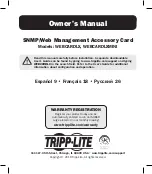
14
Table of Contents
Linksys
SNMP
This section describes the Simple Network Management Protocol (SNMP)
feature that provides a method for managing network devices
It covers the following topics:
•
SNMP Versions and Workflow
•
Model OID
•
Feature Configuration
•
Views
•
Groups
•
Users
•
Communities
•
Notification Filters
•
V1/V2 Notification Recipients
•
V3 Notification Recipients
SNMP Versions and Workflow
The device functions as SNMP agent and supports SNMPv1, v2, and v3 It
also reports system events to trap receivers using the traps defined in the
supported MIBs (Management Information Base)
SNMPv1 and v2
To control access to the system, a list of community entries is defined Each
community entry consists of a community string and its access privilege The
system responds only to SNMP messages specifying the community which
has the correct permissions and correct operation
SNMP agents maintain a list of variables that are used to manage the device
These variables are defined in the Management Information Base (MIB)
NOTE:
Due to the security vulnerabilities of other versions, it is recommended to
use SNMPv3
SNMPv3
In addition to the functionality provided by SNMPv1 and v2, SNMPv3 applies
access control and new trap mechanisms to SNMPv1 and SNMPv2 PDUs
SNMPv3 also defines a User Security Model (USM) that includes:
•
Authentication—Provides data integrity and data origin authentication
•
Privacy—Protects against disclosure message content Cipher Block-
Chaining (CBC-DES) is used for encryption Either authentication alone can
be enabled on an SNMP message, or both authentication and privacy can
be enabled on an SNMP message However, privacy cannot be enabled
without authentication
•
Timeliness—Protects against message delay or playback attacks The
SNMP agent compares the incoming message time stamp to the message
arrival time
SNMP Workflow
NOTE:
For security reasons, SNMP is disabled by default Before you can manage
the device via SNMP, you must turn on SNMP in the SNMP>Feature
Configuration page
The following is the recommended series of actions for configuring SNMP:
If you decide to use SNMPv1 or v2:
STEP 1 Navigate to the SNMP -> Communities page and click Add The
community can be associated with access rights and a view in Basic
mode or with a group in Advanced mode There are two ways to
define access rights of a community:
•
Basic mode—The access rights of a community can configure with Read
Only, Read Write, or SNMP Admin In addition, you can restrict the access
to the community to only certain MIB objects by selecting a view (defined
in the Views page)
•
Advanced Mode—The access rights of a community are defined by a group
(defined in the Groups page) You can configure the group with a specific
security model The access rights of a group are Read, Write, and Notify
STEP 2 Choose whether to restrict the SNMP management station to one
address or allow SNMP management from all addresses If you choose
to restrict SNMP management to one address, then input the address
of your SNMP Management PC in the IP Address field
Содержание Smart Switch LGS3XX
Страница 1: ...Smart Switch LGS3XX User Guide ...
















































